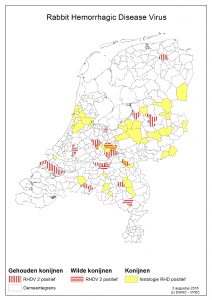Disease: Viral hemorrhagic disease (VHD) RHD
This page provides general information about this condition. Text can be revealed by clicking on the green headers. Links to press releases, results from DWHC investigations as well as other useful documents and relevant literature available on the DWHC website can be found at the bottom of the page.
Viral hemorrhagic disease (VHD) is also known as rabbit hemorrhagic disease
Pathogen
VHD is caused by infection with the RHD-virus, a Lagovirus belonging to the Caliciviridae family. There are two serotypes of RHDV: RHDV-1, also known as the classic form, and RHDV-2. Vaccination against one serotype of the virus does not offer cross-protection against infection with the other serotype. Several other non-disease-causing caliciviruses can also occur in rabbits and, depending on the relatedness to the RHD-viruses, infection with one of these non-pathogenic types can provide varying degrees of cross-protection against the RHD-viruses.
Susceptible species
Classic RHDV is almost exclusively found in wild and domestic European rabbits (Oryctolagus cuniculus) although there is one report of infection in an Iberian hare (Lepus granatensis). RHDV-2 also occurs in European rabbits and additionally in several species of hare including the Cape hare (L. capensis), Coriscan hare (L. corsicanus) and in 2014 in Germany, infection was also reported in two European hares (L. europaeus). It is unclear as to whether these species of hare act as a reservoir for RHDV.
Signs in animals
Infected animals often die before developing clinical signs of disease. Death is caused by acute liver damage with severe coagulopathy and hemorrhage.
Infection of animals
RHDV is highly infectious and is spread via direct contact between rabbits or indirectly via contact with urine and feces from infected animals or contaminated food, water and bedding. In addition the virus can be spread by biting insects (flies and midges), and feces from carnivores that had eaten infected rabbits. The virus is very resistant and can survive for long periods in carcasses.
Geographical distribution
Classic RHDV has been reported in the Netherlands since 1990 whilst RHDV-2 was first reported in the Netherlands in January 2015.
The map shows the geographic spread of the dead rabbits investigated by either the Veterinary Pathology Service Centre (domestic animals) or the Dutch Wildlife Health Centre (wildlife) and two additional cases from the GD Deventer and Harry Arts, Farmarts BV.
Up until March 2016 cases of RHD reported here were diagnosed using histology and molecular techniques (PCR) to identify the RHDV 2 serotype of the virus (negative for RHDV-1). After this time, diagnosis of cases was based on histology alone and positive cases are shown in light yellow on the map. Given the similar histologic appearance of these rabbits to those in which RHDV2 infection was diagnosed with PCR, it is presumed that the same virus serotype, RHDV2, was also the cause of disease in rabbits submitted for post-mortem after 2016.
Preventative measures
Domestic rabbits can be vaccinated against both serotypes of RHDV. More information for owners and rabbit sanctuaries can be found (in Dutch) on the University of Utrecht Vet School website.
Research results
- Tularaemia confirmed in the provinces of North Holland, Overijssel and Limburg (18/11/2019)
- Reappearance of tularaemia in the province of Utrecht (30/09/2019)
- Rabbit mortality caused by RHDV-2 continues in 2019 (18/09/2019)
- Reappearance of tularaemia in the province of Overijssel (24/04/2019)
- Not all hares die due to tularaemia (13/12/2018)
- Rabbit hemorrhagic disease type-2 still present (19/09/2017)
- First case of RHDV-2 in a hare in the Netherlands (12/01/2017)
- Deadly rabbit disease throughout the Netherlands (18/08/2016)
- New variant of rabbit virus also found in wild rabbits (08/01/2016)
- Why does VHD (RHD) pose such a risk to wild rabbits? (16/12/2015)
Projects
No projects found.
Overige berichten
No news found.
Publications
- Confirmation and phylogenetic analysis of rabbit hemorrhagic disease virus in free-living rabbits from the Netherlands. van de Bildt MW, van Bolhuis GH, van Zijderveld F, van Riel D, Drees JM, Osterhaus AD & Kuiken T. (2006). Journal of Wildlife Diseases, 2006, 42(4):808-12. Link to abstract.




